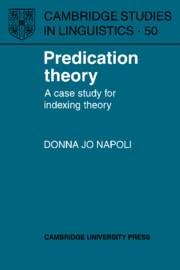Book contents
- Frontmatter
- Contents
- Acknowledgements
- Introduction
- 1 Predicates and theta-role assignment
- 2 The principles of predication coindexing
- 3 Predication coindexing within NP in Italian
- 4 Predication coindexing within NP in English
- 5 A brief look at five more constructions
- 6 An indexing theory encompassing anaphora and predication
- References
- Index of names
- Index of subjects
3 - Predication coindexing within NP in Italian
Published online by Cambridge University Press: 07 October 2009
- Frontmatter
- Contents
- Acknowledgements
- Introduction
- 1 Predicates and theta-role assignment
- 2 The principles of predication coindexing
- 3 Predication coindexing within NP in Italian
- 4 Predication coindexing within NP in English
- 5 A brief look at five more constructions
- 6 An indexing theory encompassing anaphora and predication
- References
- Index of names
- Index of subjects
Summary
In this chapter we examine phrases in Italian like quel matto di Giorgio (‘that madman Giorgio’). I argue that these phrases are externally NPs. Their internal analysis is the typical one of NPs: quel is the specifier, matto is the head N, and di Giorgio is a PP sister to the head N. I further argue that matto is a predicate taking Giorgio as its subject role player.
With the above analysis these phrases are an example of secondary predication, and they are adequately handled with the theory of predication offered in chapter 2.
Let me point out that the type of NP discussed in this chapter subdivides into two groups. In one group the NP following di is definite. In the other group, it is indefinite. These two groups, however, are syntactically identical. Thus I treat them interchangeably in sections 1 and 2 (which deal with syntax). Their differences are semantic and I discuss those differences in section 3.
Let me also point out that a typical use for these NPs is as insults (see also Milner 1978, Ruwet 1982). Many of the examples here, most of which are attested, are, therefore, obscene. In the glosses of these examples I sometimes opt for a more mild rendition than the literal in an attempt not to offend the non-Italian reader. To the Italian reader I can only say that since I am not a native speaker, I have not attempted to modify the examples offered by my informants.
The external structure of phrases like quel matto di Giorgio
I argue here that the external structure of these phrases is NP.
- Type
- Chapter
- Information
- Predication TheoryA Case Study for Indexing Theory, pp. 166 - 208Publisher: Cambridge University PressPrint publication year: 1989



